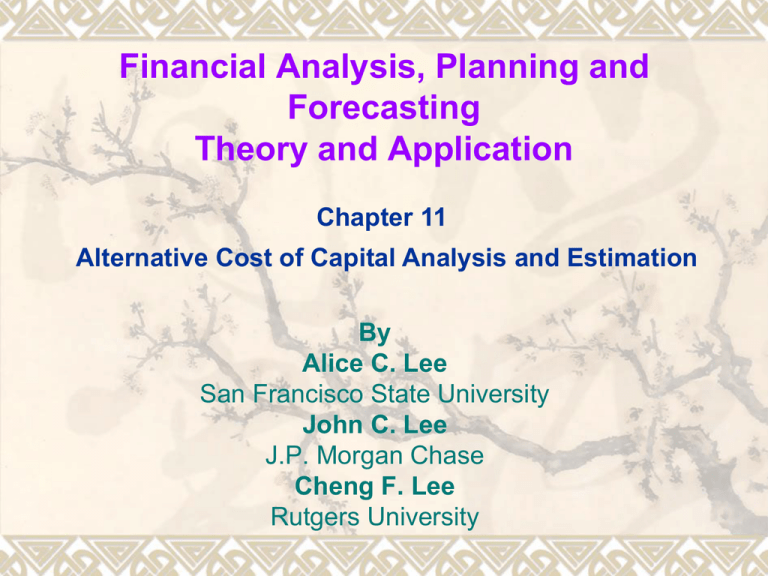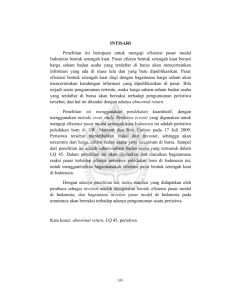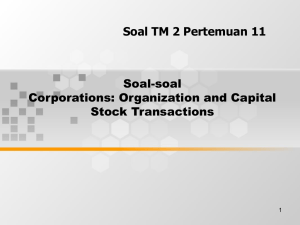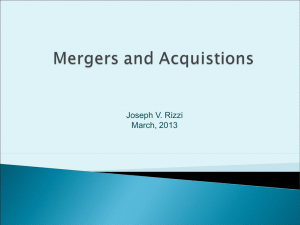PowerPoint for Chapter 11
advertisement

Financial Analysis, Planning and Forecasting Theory and Application Chapter 11 Alternative Cost of Capital Analysis and Estimation By Alice C. Lee San Francisco State University John C. Lee J.P. Morgan Chase Cheng F. Lee Rutgers University Outline 11.1 Introduction 11.2 Overview of Cost of Capital 11.3 Average earnings yield vs. current earnings yield method 11.4 Discounting cash-flow method 11.5 Weighted average cost of capital 11.6 The CAPM method 11.7 M&M’s cross-sectional method 11.8 Chase cost of capital 11.9 Summary and conclusion remarks Appendix 11A. Derivative of the basic equilibrium market price of stock and its implications 11.3 Average earnings yield vs. current earnings yield method The market value of the firm, V, can be defined as: x V= k (11.1) where x is the total expected future earnings and k is the cost of capital, then cost of capital can be estimated from x k= V (11.2) Lintner (1963) derived the rule for the marginal cost-of-capital decision as: r Ye (11.3) where r = the marginal internal rate of return, Ye = Y0/P0 is the current earnings yield,Y0 is current earnings per share, and P0 is current price per share.. 11.4 Discounting cash-flow method P0 = d1 d , then K e = 1 + g p0 Ke - g (11.4), (11.5) Percentage change method gˆ 1 + gˆ 2 + gˆ 3 + gˆ 4 ˆ = g, 4 = earnings in year t, year (t -1), respectively, and X t - X t -1 , gˆ t = X t -1 where Xt, Xt-1 gˆ t is the estimate of the growth rate in period t. Regression method X t X 0 (1 g ) X t , then ( 1+ g ) = X0 t t 11.4 Discounting cash-flow method loge EPSt a0 a1T 1t loge DPSt b0 bT 1 2t log EPSt = 0.910 + 0.015T, (0.026*) (0.020) log DPSt = -0.137 + 0.022T (0.145) (0.020) Where t-statistics are in parentheses and * indicated statistical significance under 5% significant level. 11.4 Discounting cash-flow method TABLE 11.1 EPS and DPS of Johnson & Johnson (1995-2006) Year EPSt DPSt LogEPSt LogDPSt T 1995 3.72 1.28 1.314 0.247 1 1996 2.17 0.74 0.775 -0.308 2 1997 2.47 0.85 0.904 -0.163 3 1998 2.27 0.97 0.820 -0.030 4 1999 3.00 1.09 1.099 0.086 5 2000 3.45 1.24 1.238 0.215 6 2001 1.87 0.70 0.626 -0.357 7 2002 2.20 0.80 0.788 -0.229 8 2003 2.42 0.93 0.884 -0.078 9 2004 2.87 1.10 1.054 0.091 10 2005 3.50 1.28 1.253 0.243 11 2006 3.76 1.46 1.324 0.375 12 * Standard errors are in parentheses. 11.5 Weighted average cost of capital n P I t M = + t n (1 + k d ) t=1 (1 + k d ) Interest payment kd Principle borrowed (11.6) (11.6′) (0.075)($1,000,000) $75,000 = = 7.5%. kd = $1,000,000 $1,000,000 Cost of debt K d (1 c )kd kd (0.075)(1 0.50) 3.75%. (11.7) 11.5 Weighted average cost of capital ' Ct ( M M ) / n ' (11.6′′) kd ' ( M M )/2 where M = Price at which the bond is sold in the market: M′ = Issue price of the bond (the price actually received by the issuing company); (M - M′) = Flotation cost; n = Life of the bond; Ct = Interest expense per period on one bond. [75 (1000 955) / 30] 75 (45 / 30) k 7.8% (100 955) / 2 977.5 ' d Ct [( M P) / n] k ( M P) / 2 '' d (11.6”’) 11.5 Weighted average cost of capital N V C t M = + t N (1 + k dc ) t=1 (1 + k dc ) where (11.8) MC = Market price of the convertible bond; Ct = Interest payment on the convertible bond in period t; N = Time to conversion; V = Forecast value of the bond on termination. ( 1/n)(V - M c ) . k dc = C t + 1 2 (V + M c ) 11.5 Weighted average cost of capital PN = P0(1 - Cf) (11.9) where PN = Net price of the stock, P0 = Market price of the new stock, Cf = Percentage flotation cost. PN = 22(1 - 0.05) = 20.90. Use PN into (11.5) 1.10 d1 + 0.05 = 10.3. + g , ke= Ke= 20.90 PN 1.00 D P (11.10) = 10.127%. , k p= K P= 9.875 Pp 11.5 Weighted average cost of capital TABLE 11.2 XYZ financing Component Calculation Cost of Component Debt(no flotation cost) Total interest $75, 000 Principal borrowed $1, 000, 000 7.5% After tax (1-0.50)(7.5%) 3.75% (100 95) 30 100 95 2 7.5 Debt (with flotation cost) After tax 7.87% (1-0.50)(7.8%) 3.9% Retained earnings 1.10 0.05 22.00 10.0% New preferred stock 1.00 9.875 10.125% New equity 1.10 0.05 20.90 10.3% 11.5 Weighted average cost of capital Market value outstanding of component Weight= Total assets (11.11) (Book value of retained earnings) (Market value of common stock) (Book value of total assets) (11.11a) n WACC = W i K i i (11.12) 11.5.1 Theoretical Justification of the WACC D ΔD , = 1 WACC = 1 - c WACC τ c ΔV A D K e = + (1 c )( k d ) , S (11.13), (11.14) (11.15) D / S is changes in market value ratio of debt to equity D (11.15’) K e = + 1 c kd S D S WACC = (1 - τ c) K d + Ke (11.16) D S D S 11.5.1 Theoretical Justification of the WACC D S D WACC (1 c )kd (1 )( k ) c d S D S D S D S D S D S (1 c )kd (1 ) (1 ) k c c d DS DS S D S S D S D D S D D (1 c )kd (1 ) k c c d DS D S D S DS DS D 1 c , D S 11.5.1 Theoretical Justification of the WACC (1 - τ c)(1 - τ ps) V =V + 1D (1 - τ pD) L U (6.32) where VU = Market value of unlevered firm, c = Corporate tax rate, ps = Capital gains tax rate, pD = Tax rate on ordinary income, D = Market value of debt. (1 pD ) (1 ps )(1 c ) 11.6 The CAPM method Fig. 11.1 Application of the asset-expansion criterion. 11.6 The CAPM method D = + E 1 WACC R f Rm Rf C A τ (11.17) E( R j ) = R f + [E( R m ) - R f ] j + E( R z )(1 - j ) + E( R h )( d i - j d m ) (11.18) where Rj, Rm, and ßj are defined in Chapter 6, E( Rz)= The risk premium on a portfolio having a zero beta and zero dividend yield, E( Rh) = Expected rate of return on a hedge portfolio having zero beta and dividend yield of unity, di = Dividend yield on stock i, and dm = Dividend yield on the market portfolio. 11.6 The CAPM method TABLE 11.3 Means and standard deviations for three estimates of the cost of equity for the electric utility industry (standard deviations in parentheses) Year E/P Ke Rj 1967 .0558 (.0077) .1033 (.0169) .1054 (.0140) 1968 .0589 (.0077) .1119 (.0186) .1063 (.0149) 1969 .0663 (.0088) .1340 (.0225) .1209 (.0140) 1970 .0713 (.0092) .1451 (.0283) .1252 (.0143) 1971 .0752 (.0090) .1576 (.0330) .1010 (.0133) 1972 .0788 (.0091) .1657 (.0354) .1034 (.0152) 1973 .0880 (.0088) .1891 (.0395) .1285 (.0157) 1974 .1031 (.0119) .2381 (.0566) .1313 (.0156) 1975 .1115 (.0146) .2009 (.0388) .1258 (.0163) 1976 .1167 (.0166) .1905 (.0350) .1202 (.0159) 11.7 M&M’s cross-sectional method The cost of capital Regression formulation and empirical results 11.7 M&M’s cross-sectional method 11.7.1 The cost of capital V= X (1 c ) k + cD (11.19) where V = Sum of the market value of all securities issued by the firm, X = Expected level of average annual earnings generated by current assets, c = Corporate tax rate, k = Cost of unlevered equity capital in a certain designated risk class, D = Market value of a firm’s debt. 11.7 M&M’s cross-sectional method V = S + D + P, (11.20) Where S = Common equity, D = Debt, P = Preferred equity V S 0 S n P D S 0 = + + + = +1 A A A A A A (11.21) where V = Change of market value of a firm, A = Sn + P + D = New investment in real asset, S0 = Change in the market value of the shares held by the current owners of the firm, Sn = Value of any new common stock issued, P = Value of any new preferred stock issued, D = Value of any new debt issued. 11.7 M&M’s cross-sectional method V S X (1 - c ) cD = + 1= + A A A k A (11.22) X ΔD (1 - τ c) > k 1 τ c ( ) = C A ΔA (11.23) 0 * - C V = 1 - c X + c D + K X 1 - c C(1 + C) n (11.24) 11.7 M&M’s cross-sectional method 11.7.2 Regression formulation and empirical results (V c D) a0 a1 X (1 c ) a2 (growth potential) (11.25) A t - At-5 A= ( ) At 1 5 At (V - τ cD) a 0 (1 - τ c) A = + a1 X + a2 +u A A A A Vi * X i* j Z ij ui j (11.26) (11.27) (11.28a) X i X vi , X j Z ij wi (11.28b), (11.28c) * i * i j 11.7 M&M’s cross-sectional method Vi X i j Zij U , Xˆ i* ˆ j Zij * (11.29), (11.30) (r - k) I 0 (g -k)t dt e k 0 T The integral yields (11.31) 1 (g-k)T - 1] [e g-k 1 (g-k)T = 1 1 e g k 1 1 k g T = T g - k (11.32) (r k ) I 0T S = Y 0 + (r - k) I 0T , k = Y 0 + r I 0T (11.33), (11.34) , 0 k k S 0 + I 0T , and (11.35) k 11.7 M&M’s cross-sectional method (r k ) I 0 Y 0k I 0k + r I 0 gY 0 Y 0 S0 + k k (k g ) k (k - g ) gY0 rbY0 , r I 0 rbY0 , (11.36) Y Y 0k - I 0k 0 - I0 = S0= k(k - g) k-g (11.37), (11.38) D0 , = S0 k-g S a2Y a3r I a4 I S 1 Y r I I = a0 + a1 + a 2 + a 3 + a4 +e A A A A A (11.39) 11.7 M&M’s cross-sectional method The direct least squares estimates ke with Constant ke without Constant 1957 0.0637 0.0625 1956 0.0641 0.0602 1954 0.0730 0.0521 The two-stage estimates ke with Constant 1957 1956 1951 0.0617 0.0641 0.0552 Direct Two-Stage 1957 0.164 0.004 1956 0.057 0.054 1954 0.274 0.072 ke without Constant 0.0621 0.0599 0.0508 11.8 Chase cost of capital NOPAT V= + cD, C V=E+D NOPAT E + D= + cD C NOPAT = C(E + D - cD) (11.40), (11.41) (11.42) (11.43) NE NOPAT - bD(1 - c ) Y= = E E (11.44) C(E + D - cD) - bD(1 - c ) Y= E (11.45) 11.8 Chase cost of capital Y + (1 - c )(D/E)b C= 1 + (1 - c )(D/E) D C = C 1 - ( τ c) CE (11.46) * Y = R + ß(P) = 8% + 0.95(5%) = 12.75%. (11.47) 11.8 Chase cost of capital D Y = C + ( 1 c )(C - b) E (11.48) where c = Marginal tax rate over the past five years; b = Interest rate on all debt over the past five years; D/E = Average total debt to total equity over the past five years. (Debt included capitalized leases, and equity includes deferred items and minority interest.) 11.8 Chase cost of capital Y + (1 - c )(D/E)(b) C= . 1 + (1 - c )(D/E) 12.75% + (1 0.5)(0.60)(7%) C 1 + (1 0.5)(0.60) 12.75%+2.10% 14.85% 11.42% 1+0.30 1.30 D C* C 1 ( c ) = 11.42%[1 0.5(0.40)] CE 11.42%(.80) 9.14% (all figures are hypothetical) 11.9 Summary and conclusion remarks Based upon the valuation models and capital-structure theories presented earlier, six alternative cost-of-capital determination and estimation methods are discussed in detail. These methods are (i) average earnings yield method, (ii) DCF method, (iii) WACC method, (iv) CAPM method, (v) M&M’s cross-section method, and (vi) Chase’s method. The interrelationship among different cost-of-capital estimation methods were explored in some detail. The relative advantages between different estimation methods were also indirectly explored. The six cost-of-capital estimation methods that were discussed in this chapter give managers enough background to choose the appropriate cost-of-capital estimation method for utilityregulation determination, capital-budgeting decisions, and financial planning and forecasting. Appendix 11A. Derivative of the basic equilibrium market price of stock and its implications yd + d ln Pt/dt = kt (11.A.1) where yd Dt / Pt dividend yield, 1 dP d ln pt / dt Capital gain yield, P dt kt Required rates-of-return. Appendix 11A. Derivative of the basic equilibrium market price of stock and its implications dPt kPt Dt dt (11.A.2) kdt Pt e [ D0 e gt e kt C ] gt kt e e kt [ D0 d ( gt kt ) C ] g k kt D0 gt kt e C (general solution), e k g gt e D (special solution). 0 k g (11.A.3a) (11.A.3b) Appendix 11A. Derivative of the basic equilibrium market price of stock and its implications XY0 XY0 D 0 = = (k > g) P0 = * k - g k - g k - ( g - n) 1 dg / db dP0 Y0 0 db b kg (11.A.4) dP0 k g Y0 r ye db b P0 (11.A.5) V0 r k 1 ( ) [k 1 - k 0] I (11.A.6)


